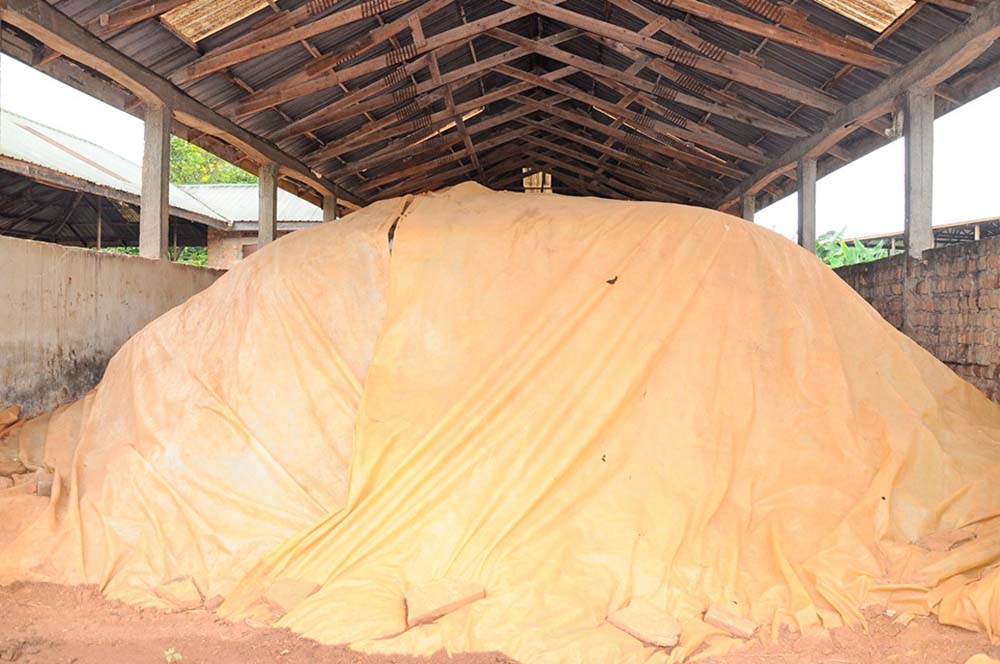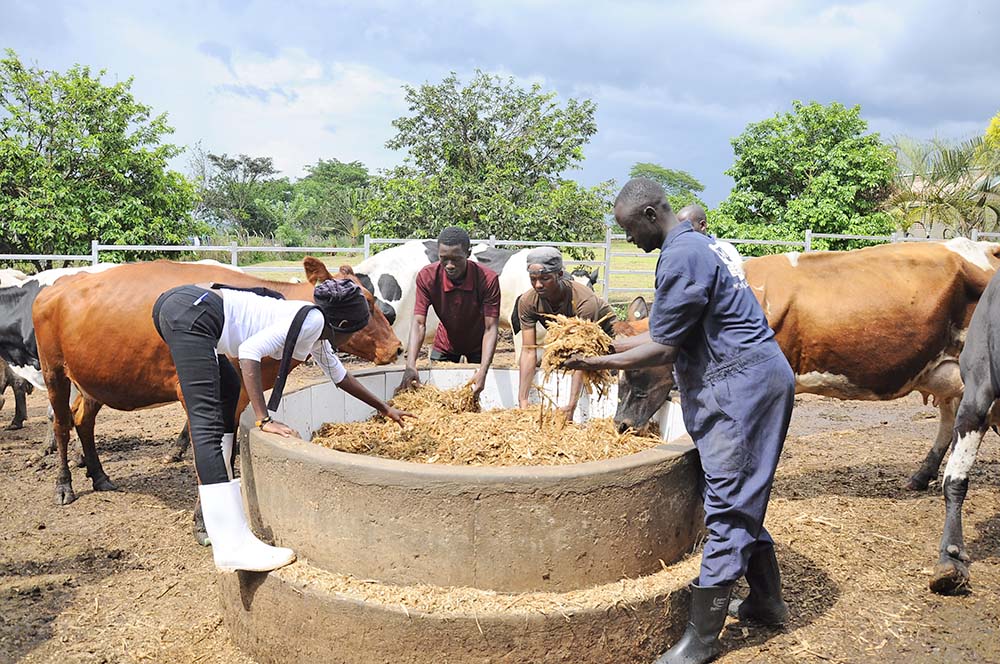Livestock farming is one of the versatile sectors in Uganda that employs about 60% of Uganda’s population, according to research from the agriculture ministry.
It supports millions of households and contributes substantially to the economy. However, many farmers suffer many countless losses, owing to limited and poor information flow.
Other farmers also continue to face many other challenges that include disease outbreaks, fake agro-products, dealing with drought as well as struggling to find the right advice on product pricing and local markets.
Additionally, many farmers, especially those that are urban-based, struggle to access quality feeds, yet investing in silage production can salvage the situation. Silage is an emerging source of feeds among cattle keepers. It is produced by controlled fermentation of chopped crop residues or forages with high moisture content.
Sabastian Ruta Ngambwa, the director Prime Agro Farms Uganda Limited and expert in silage making, says silage making is simple depending on the type of silo you intend to use.
“Assuming you want to prepare silage in a pit, first dig the pit then spread plastic polythene on the floor and walls,” he advises.
Ngambwa says the fermentation in silage reduces harmful nitrates accumulated in plants during droughts and in over-fertilised crops.
He says the best strategy in dairy farming is to establish a target level of production and securing a market for the milk market. Additionally, for one to get clean milk that is free of aflatoxins and other impurities, they should not make silage from rotten maize.
“After harvesting your maize fodder at the right stage, chop them to about one inch lengths then spread into the pit to about 15cm high,” Ngambwa explains.
Maize silage has 30-50% higher nutritive value compared to maize grain and maize straw. Before the maize in the field is harvested, it must attain certain attributes to meet nutritional requirements for dairy cows.
“The crop should have a high ratio of leaves to stem, good cob and grain that has not been damaged or rotten. Leaves should be green, the stem thick to ensure good mixture of stem, leaves and grains,” Ngambwa explains.
Silage will be ready for feeding to cows in 30 to 40 days. To feed, open the pit and remove silage enough for feeding each day then cover again to regulate the air getting in.
Peter Mubiru, a veterinary doctor, says silage should be fed as soon as possible, preferably within a few hours after opening the silos.
He emphasizes that the maize used in silage preparation should have clean grains that are not rotten or damaged; one can get aflatoxin-free feeds.
Making the best nutritious silage
Silage and hay are preserved feeds that come in handy for dairy cows during periods of scarcity of green forage.
The process of making silage involves fermentation under anaerobic conditions. It prevents fresh fodder from decomposing and allows it to keep its nutrient quality.
When you feed your cows on silage it ensures high milk production and healthy dairy animals, especially during dry seasons.
Silage preparation
Ngambwa says preparing silage using the corn crusher enables one to get the right size of the feeds that will not cause problems to the cattle during feeding and digestion.
“Once crushed, the feed is transported by a tractor to the location where it is spread on plastic sheets for compaction,” he explains.
Ngambwa says they get at least 18 tonnes of silage from each acre, which is equivalent to 31 bags per acre of commercial maize.
“In the past, farmers have been digging and burying the silage underground. But we don’t do that to avoid rotting since the maize crop has high moisture content. We place ours on top of dry wheat straws,” he observes.
Silage is produced through use of pits or trenches, towers and sacks for small quantities. However, pits are mostly used to prepare silage for large dairy units.
The silage pit should be located at a place safe from rodents, away from direct sunlight and with higher elevation or slightly sloppy to avoid rain water entering into the facility.

Silage quality
Silage can be classified as good quality depending on its physical characteristics like taste, smell and colour, but more precisely by measuring the pH in the pit.
A dairy cow is fed depending on the body weight or generally be given about 6-15 kilogrammes silage per day.
It is advisable not to feed silage immediately before or during milking, especially when the quality is poor as the milk can easily take the smell of the feeds.
Rodent control
– Monitor the silage bags on a regular basis for any rodent, bird or livestock damage;
– Do not use chemical means for rodent/pest control, as life expectancy of the plastic is reduced when exposed to chemicals;
– Storage (shelves) can be constructed with stands in order to keep the store off the ground.
Utilisation of silage
-Silage is ready for feeding at least 30 days after making it.
– Silage should be fed as soon as possible, preferably within a few hours after opening the silos.
– Only use the silage in times of shortage of green fodder
– Silage cannot replace concentrates. Therefore, supplement your dairy cows with concentrates when using silage.
– Silage can be provided to animals in many different recipes based on its composition and the breed and use of the animals.
Silage can be mixed with grass hay or fresh fodder.
-To avoid off flavours in milk, silage should be fed to lactating cows at least two hours before milking or after milking the animals.
-After feeding, the feed troughs must be cleaned out to prevent any remaining silage, which will spoil, contaminating the next feed out.
-Each time after you open a silage bag and remove some silage, expel air from the bag and then tie the remaining silage tightly to avoid spoilage.
– Monitor the silage bags on a regular basis for any rodent, bird or livestock damage; Silage for different stock.

Prices
“We sell a kilo of loose silage at sh350, but the price is a little higher on the retail market.
Ngambwa advises that during preservation, one should properly manage the silage to maintain the quality and attract a good, sustainable market.
Prime Agro Uganda Limited produce one of the best silage in the country. The gardens are well maintained and the distance from the field to pits is short, which ensures quality silage.
Advantages
– Silage making eases the serious feed shortages experienced in the dry season.
– Stable composition of the feed (silage) for a longer period (up to five years).
– Plants can be harvested at an optimal phase of development and are efficiently used by livestock.
– Reduction of nutrient loses which in standard hay production may amount to 30% of the dry matter (in silage is usually below 10%).
– More economical use of plants with high yield of green mass.
– Better use of the land with two to three crops annually.
– Silage is produced in both wet and cloudy dry weather conditions.
– The fermentation in silage reduces harmful nitrates accumulated in plants during droughts and in over-fertilized crops.
– Silage production allows crop by[1]products to be optimally used.
– Requires 10 times less storage space compared to hay.
– Maize silage has 30-50% higher nutritive value compared to maize grain and maize straw.
– Two (2) kilogrammes of silage (70% moisture) has the equal nutritive value of 1 kg of hay.
– With adequate feed available year-round, animals remain in good condition.
– Advantage can be taken of the higher milk price during periods of feed shortages.


Disadvantages
– It requires a silo (a permanent structure) in comparison with the simpler methods of field curing and storing hay, this is likely to mean higher costs for smallholder farmers.
– Wastage may be more, if silage is not properly made or stored.
– Poorly prepared silages are not accepted by animals.
– It possesses considerably less vitamin D than sun-cured hay.
– Ensiling incurs an added expenditure when preservatives are necessary.
– Extra labour is needed at silo-filling time.
– Transportation problem is generally experienced in silage than for hay.






